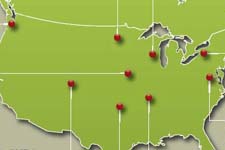Federal government offices in Washington, D.C., closed for the third straight day today as back-to-back winter storms pushed the region toward the heaviest single season of snowfall on record. The U.S. House of Representatives has bailed on the entire week of legislating. The Postal Service has given up delivering the mail. And in the streets, officials have started rationing salt.
Amid the chaos — “Snowmaggedon,” residents are calling it — opposing camps of the climate debate have finally found something they can agree on: Here it is, the evidence we’ve been talking about!
Never mind that they’re talking about evidence for two conflicting theories.
Environmentalists and scientists say the record-breaking snowfall — and coming as it is across the Southern state of Virginia — is just the kind of extreme weather anomaly we’re in for if we keep disrupting Mother Nature’s natural rhythms. For the skeptics, the storm is sweet irony: How can we debate global warming when there’s a blizzard outside? In Washington, of all places!
“It’s going to keep snowing in DC until Al Gore cries ‘uncle,'” tweeted South Carolina Sen. Jim DeMint on Tuesday.
Climate crusader Gore has been a frequent target of metaphorical snowballs this week. Sen. James Inhofe, Congress’ most vocal global warming denier — and the leader of a boisterous protest delegation to Copenhagen in December — is needling the former VP, too. Inhofe’s family spent one of the snow days building an igloo behind the Capitol building and hung this homey welcome sign:

Miller-McCune’s Washington correspondent Emily Badger follows the ideas informing, explaining and influencing government, from the local think tank circuit to academic research that shapes D.C. policy from afar.
“AL GORE’S NEW HOME! …HONK IF YOU © GLOBAL WARMING.”
Inhofe and DeMint likely did not read a report the National Wildlife Federation released just a week before the snow started falling (again). The report, “Oddball Winter Weather: Global Warming’s Wake-up Call for the Northern United States,” includes mention of the equally oddball winter snowstorm that dumped 2 feet on D.C. in December. That another such strong example of the phenomenon would immediately follow was just good luck for the report’s authors (but, they would probably argue, not at all a matter of luck for the rest of us).

“Oddball winter weather is yet another sign of how uncontrolled carbon pollution amounts to an unchecked experiment on people and nature,” NWF climate scientist Amanda Staudt said in the federation’s statement releasing the report. “While global warming means shorter, milder winters on average, some snowbelt areas will see more heavy snowfall events. Disruptions to tourism and recreation economies will become increasingly common — for example to skiing and ice fishing that depend on predictable conditions. Snow removal, wintertime floods, agriculture, and forestry will also become increasingly more difficult to manage.”
Washington-area snow plows are now so perplexed by where to put all the stuff, they’re trucking it to makeshift dumps. The NWF report warns of just this dilemma: As average winters grow milder, our ability to handle the anomalies will dramatically decrease. Washington, which typically gets about 16 inches of snowfall a year, is hardly equipped to handle more than 4 feet of it this go around.
And speaking of disruption, it’s a compelling case study when the life being disrupted isn’t on a ski resort or in an ice-fishing camp, but inside the federal government.
A similar snowstorm anywhere south of the Mason-Dixon would prompt the same climate change fight (and, if nothing else, this is a prime example of why scientists now want to call it “climate change” instead of “global warming”). But coming as it is in the capital, where some of the most prominent snowed-in residents (and tweeters) are U.S. senators, the Idea Lobby has to wonder: Once we finish digging out, will the great Snowmageddon of 2010 yield some after effects for climate policy?
Sign up for our free e-newsletter.
Are you on Facebook? Become our fan.
Follow us on Twitter.




